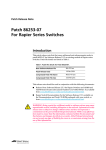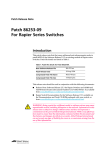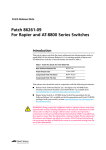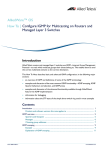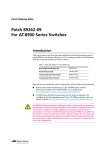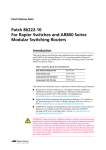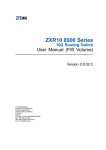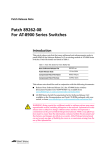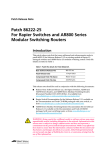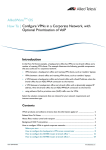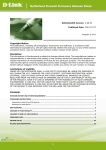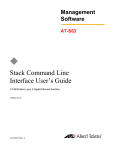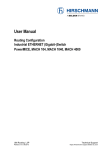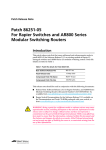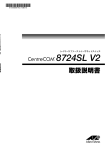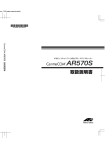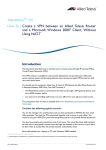Download Allied Telesis Patch 86261-04 User's Manual
Transcript
Patch Release Note
Patch 86261-04
For Rapier and AT-8800 Series Switches
Introduction
This patch release note lists the issues addressed and enhancements made in
patch 86261-04 for Software Release 2.6.1 on existing models of Rapier and
AT-8800 Series switches. Patch file details are listed in Table 1.
Table 1: Patch file details for Patch 86261-04.
Base Software Release File
86-261.rez
Patch Release Date
19-Nov-2003
Compressed Patch File Name
86261-04.paz
Compressed Patch File Size
261628 bytes
This release note should be read in conjunction with the following documents:
■
Release Note: Software Release 2.6.1 for Rapier and AT-8800 Series
Switches (Document Number C613-10383-00 Rev A) available from
www.alliedtelesyn.co.nz/documentation/documentation.html.
■
Rapier Series Switch or AT-8800 Series Switch Documentation Set for
Software Release 2.6.1 available on the Documentation and Tools CD-ROM
packaged with your switch, or from www.alliedtelesyn.co.nz/documentation/
documentation.html.
WARNING: Using a patch for a different model or software release may cause
unpredictable results, including disruption to the network. Information in this
release note is subject to change without notice and does not represent a
commitment on the part of Allied Telesyn International. While every effort has
been made to ensure that the information contained within this document and
the features and changes described are accurate, Allied Telesyn International
can not accept any type of liability for errors in, or omissions arising from the
use of this information.
Simply connecting the world
2
Patch Release Note
Some of the issues addressed in this Release Note include a level number. This
number reflects the importance of the issue that has been resolved. The levels
are:
Level 1
This issue will cause significant interruption to network services, and
there is no work-around.
Level 2
This issue will cause interruption to network service, however there
is a work-around.
Level 3
This issue will seldom appear, and will cause minor inconvenience.
Level 4
This issue represents a cosmetic change and does not affect network
operation.
Features in 86261-04
Patch 86261-04 includes all issues resolved and enhancements released in
previous patches for Software Release 2.6.1, and the following enhancements:
PCR: 03910
Module: IPG
Level: 3
When RIP demand mode was enabled, and one interface changed to a
reachable state, the triggered Request packet was not sent from that
interface, and triggered Response packets were not sent from all other RIP
interfaces. This resulted in slow convergence of routing tables across the
network. This issue has been resolved.
PCR: 03927
Module: BRI
Support has been added for the AT-AR021 (S) BRI-S/T PIC (Port Interface
Card) with basic rate ISDN.
PCR: 03967
Module: IPG
Level: 2
RIP did not send the correct next hop address if the route originated from a
different subnet to that of the egress interface. This issue has been resolved.
PCR: 03970
Module: IPV6
Level: 3
If an IPv6 filter that blocked traffic on a VLAN interface was removed, the
traffic was still blocked. This issue has been resolved.
PCR: 03978
Module: OSPF
Level: 3
Occasionally an error occurred with OSPF’s route table calculation, so all
routes in the network were not discovered. The error only happened with a
network topology that involved connections between routers via both a
Point to Point link and a transit network link. This issue has been resolved.
A new command has been added that forces a route table recalculation by
rerunning the Shortest Path First calculation. The command is:
RESET OSPF SPF [DEBUG]
If DEBUG is specified, debugging information for the route table calculation
is output to the port from which the command was executed. SPF
debugging can be turned on for every route table calculation using the
ENABLE OSPF DEBUG=SPF command, but this will be overridden if
DEBUG is specified with the RESET OSPF SPF command.
Patch 86261-04 for Software Release 2.6.1
C613-10386-00 REV D
Patch 86261-04 For Rapier and AT-8800 Series Switches
PCR: 31009
Module: HTTP
3
Level: 3
The server string was not copied correctly into an HTTP file request when
loading information from the configuration script. This issue has been
resolved.
PCR: 31064
Module: SWI
Level: 2
When 10/100 copper ports were disabled with the DISABLE SWITCH
PORT command, their link state was still UP. This issue has been resolved.
PCR: 31072
Module: SWI
Level: 3
If the DISABLE SWITCH PORT command appeared in the configuration
script, an interface could come up even though ifAdminStatus was set to
‘down’. This issue has been resolved.
PCR: 31084
Module: IPV6
Level: 2
A fatal error sometimes occurred because of incorrect responses to
Neighbour Solicitation messages. This issue has been resolved.
PCR: 31093
Module: SWI
Level: 1
If a switch port was disabled on a switch running STP, traffic was sometimes
not passed through that port after it was re-enabled. This issue has been
resolved.
PCR: 31096
Module: FFS
Level: 3
The SHOW FILE command caused an error when the displayed file had a
duplicate entry due to file size mismatch. This issue has been resolved. An
error message is now logged when the SHOW FILE command detects a
duplicate file. The first FFS file will be deleted when a duplicate exists.
PCR: 31098
Module: DHCP
Level: 3
Static DHCP address ranges were not reclaimed if the Reclaim operation was
interrupted by the interface going down. This issue has been resolved.
PCR: 31100
Module: L2TP
Level: 3
An error occurred in L2TP when call names consisted of numeric characters
only. This issue has been resolved. The ADD L2TP CALL command now
only accepts call names that contain at least one alphabetic character.
PCR: 31119
Module: LOG
Level: 2
The maximum value that the MESSAGES parameter accepted for the
CREATE LOG OUTPUT command was different from the value that could
be set with the SET LOG OUTPUT command. The DESTROY LOG
OUTPUT command did not release the NVS memory that was reserved for
the output. These issues have been resolved.
PCR: 31132
Module: DHCP
Level: 2
The DHCP server did not take any action when it received a DHCP decline
packet. This was because the device only checked the ciaddr field in the
packet, and not the RequestedIPAddress option. This issue has been resolved.
Patch 86261-04 for Software Release 2.6.1
C613-10386-00 REV D
4
ADD IGMPSNOOPING ROUTERADDRESS
PCR: 31133
Patch Release Note
Module: IPG
This PCR introduces an enhancement that extends an issue that was
resolved in PCR 03890, in which switch port entries are only created for
special router multicast addresses. It is now possible to specify reserved
multicast addresses that will be treated as multicast packets from routers.
Use the following commands to configure this feature.
ADD IGMPSNOOPING ROUTERADDRESS
Syntax
Description
ADD IGMPSNOOPING ROUTERADDRESS=ipaddr[,...]
where:
•
ipaddr is a reserved IP multicast address in dotted decimal notation.
This command adds reserved IP multicast addresses to the list of router
multicast addresses. The IP address specified must be within the range
224.0.0.1 to 224.0.0.255. This command is only valid if the IGMP snooping
router mode is set to IP with the SET IGMPSNOOPING ROUTERMODE
command.
SET IGMPSNOOPING ROUTERMODE
Syntax
Description
SET IGMPSNOOPING ROUTERMODE=
{ALL|DEFAULT|IP|MULTICASTROUTER|NONE}
This command sets the mode of operation for IGMP Snooping.
If ALL is specified, all reserved multicast addresses (i.e. 2240.0.1 to
224.0.0.255) are treated as router multicast addresses.
If DEFAULT is specified, the following addresses are treated as router
multicast addresses:
•
IGMP Query: 224.0.0.1
•
All routers on this subnet: 224.0.0.2
•
DVMRP Routers: 224.0.0.4
•
OSPFIGP all routers: 224.0.0.5
•
OSPFIGP designated routers: 224.0.0.6
•
RIP2 routers: 224.0.0.9
•
All PIM routers: 224.0.0.13
•
All CBT routers: 224.0.0.15
If IP is specified, addresses that are treated as router multicast addresses are
specified with the ADD/DELETE IGMPSNOOPING ROUTERADDRESS
command. In this mode, the switch will retain previous addresses that have
already been specified.
If MULTICAST is specified, the following addresses are treated as router
multicast addresses:
•
DVMRP Routers: 224.0.0.4
•
All PIM routers: 224.0.0.13
If NONE is specified, no router ports are created.
Patch 86261-04 for Software Release 2.6.1
C613-10386-00 REV D
Patch 86261-04 For Rapier and AT-8800 Series Switches
SHOW IGMPSNOOPING ROUTERADDRESS
5
DELETE IGMPSNOOPING ROUTERADDRESS
Syntax
DELETE IGMPSNOOPING ROUTERADDRESS=ipaddr[,...]
where
•
Description
ipaddr is a reserved IP multicast address in dotted decimal notation.
This command deletes reserved IP multicast addresses from the list of router
multicast addresses. The IP address specified must be within the range
224.0.0.1 to 224.0.0.255. This command is only valid if the IGMP snooping
router mode is set to IP with the SET IGMPSNOOPING ROUTERMODE
command.
SHOW IGMPSNOOPING ROUTERADDRESS
Syntax
Description
SHOW IGMPSNOOPING ROUTERADDRESS
This command displays information about the list of configured IP multicast
router addresses currently configured on the switch (Figure 1).
Figure 1: Example output for SHOW IGMPSNOOPING ROUTERADDRESS
IGMP Snooping Router Address
---------------------------------------------------------------------------IGMP Snooping Router Mode ...... IP
Router Address List
-------------------------------224.0.0.4
224.0.0.6
224.0.0.80
224.0.0.43
224.0.0.23
224.0.0.15
224.0.0.60
----------------------------------------------------------------------------
PCR: 31134
Module: RSTP
Level: 2
Bridges transmitted BPDUs at the rate specified by the local helloTime value
when they were not the root bridge. This is the behaviour specified in
802.1w-2001. This behaviour can cause instability in the spanning tree when
bridges are configured with different helloTime values, especially when the
root bridge's helloTime is significantly less than other bridges in the tree. This
issue has been resolved. Non-root bridges now adopt the root bridge's
helloTime value propagated in BPDUs.
PCR: 31135
Module: IPV6
Level: 3
The ADD IPV6 HOST command accepted an invalid IPv6 address. This
issue has been resolved.
Patch 86261-04 for Software Release 2.6.1
C613-10386-00 REV D
6
SHOW IGMPSNOOPING ROUTERADDRESS
PCR: 31140
Patch Release Note
Module: FIREWALL
Level: 4
The firewall sent an erroneous IPSPOOF attack message when processing
large packets. This issue has been resolved.
PCR: 31145
Module: SWI
Level: 3
The port counters were not incremented:
•
ifInDiscards
•
ifinErrors
•
ifOutDiscards
•
ifOutErrors
This issue has been resolved.
PCR: 31146
Module: SWI
Level: 3
The following SNMP MIB objects could not be set:
•
Dot1dStpPriority
•
Dot1dStpBridgeMaxAge
•
Dot1dStpBridgeHelloTime
•
Dot1dStpBridgeForwardDelay
This issue has been resolved.
PCR: 31147
Module: DHCP
Level: 3
DHCP was incorrectly using the directly connected network interface
source IP address as the source IP address of packets it generates. This issue
has been resolved. DHCP now uses the local IP address as the source
address for the packets it generates when a local IP interface address is set.
If a local IP interface address is not set, then it uses the IP address of the
interface where packets are sent from as the source address.
PCR: 31148
Module: PIM, PIM6
Level: 2
When the device rebooted with PIM or PIM6 enabled, it sometimes did not
send a Hello packet quickly enough. This issue has been resolved.
PCR: 31152
Module: DHCP
Level: 2
When a DHCP client was in the renewing state, and it sent a DHCP Request,
the device did not add the ARP entry to the ARP table. Instead, the device
generated an ARP Request in order to transmit the DHCP Ack. This caused
a broadcast storm in the network when the client kept sending DHCP
Requests. This issue occurred because the ciaddr field, not the giaddr field,
was checked in the Request packet when the device determined whether to
add the ARP entry. This issue has been resolved.
PCR: 31153
Module: IPG
Level: 4
In the output of the SHOW IP DNS CACHE command, “TTL” was
displayed as seconds. This has been changed to minutes because the TTL is
updated every minute.
Patch 86261-04 for Software Release 2.6.1
C613-10386-00 REV D
Patch 86261-04 For Rapier and AT-8800 Series Switches
PCR: 31154
SHOW IGMPSNOOPING ROUTERADDRESS
Module: STP
7
Level: 4
The current implementation of RSTP conforms to the IEEE standard
802.1w-2001. However, several minor deviations from the standard are
possible without having a functional impact on the behaviour of RSTP.
These changes are useful for debugging RSTP, and tidy up aspects of RSTP
that sometimes have no purpose. The following three variations have been
implemented:
•
The Learning and Forwarding flags are set in BPDUs to indicate the state
of the Port State Transition state machine.
•
The Agreement flag is set in BPDUs only when a Root Port is explicitly
agreeing to a proposal from a designated port. Do not set the Agreement
flag in BPDUs transmitted by Designated Ports.
•
The Proposal flag is not set in a BPDU sent by a designated port once the
port has reached the forwarding state.
PCR: 31158
Module: CORE
Level: 3
On AT-8800 series switches, when the fan status changed, the device did not
send a SNMP trap and log. When the temperature was above the allowable
threshold, the device sent the wrong SNMP trap. This issue has been
resolved. Also, the temperature thresholds of the AT-8824 and AT-8848 have
been set to different values of 62º C and 67º C respectively.
PCR: 31159
Module: FW, VLAN
Level: 2
Static ARP entries sometimes prevented the firewall from working
correctly. This is because when an VLAN interface is added to the firewall,
the CPU takes over the routing from the switch silicon in order to inspect
the packet. Hence all the Layer 3 route entries must be deleted. However,
static ARP Layer 3 entries were not being deleted from the silicon. This issue
has been resolved. When interface is added to the firewall, all hardware
layer 3 routing is now turned off to allow the firewall to inspect packets.
PCR: 31161
Module: LOG
Level: 3
If the number of messages to be stored in the TEMPORARY log output was
changed with the SET LOG OUTPUT MESSAGE command, the SHOW
LOG command output did not return any matching log messages. This
issue has been resolved. Existing messages are now displayed.
PCR: 31162
Module: SWI
Level: 2
A STP topology change incorrectly deleted static ARP entries. This issue has
been resolved.
PCR: 31167
Module: IPG
Level: 2
IP MVR member ports were not timing out. MVR member ports now
timeout in the same way as IP IGMP ports. The timeout values are
configured by IGMP. Also, IGMP interfaces were incorrectly being enabled
and disabled by MVR. This issue has been resolved.
PCR: 31170
Module: SWI
Level: 2
After an AT-8800 series switch was powered down or rebooted, non-auto
negotiating copper GBICs were not handled correctly. This issue has been
resolved.
Patch 86261-04 for Software Release 2.6.1
C613-10386-00 REV D
8
SHOW IGMPSNOOPING ROUTERADDRESS
PCR: 31171
Patch Release Note
Module: PORTAUTH, USER,STP
Level: 2
This PCR enhances the robustness of the 802.1x port authentication
protocol.
PCR: 31174
Module: IPG
Level: 2
If a device had IPSec and firewall enabled, it could not handle long ICMP
packets even when enhanced fragment handling was enabled on the
firewall. If a long packet is passed to the firewall for processing, the firewall
chains the fragmented packets. The firewall can process chained packets,
but IPSec could not process these packets, and dropped them. This was only
an issue for packets between 1723 and 1799 bytes long. This issue has been
resolved. The way IP processes fragmented packets has been changed so
that IPsec no longer drops chained packets.
PCR: 31179
Module: SWI
Level: 3
Addresses learned with static port security were not added to the
configuration when the CREATE CONFIG command was executed. This
issue has been resolved.
PCR: 31180
Module: USER
Level: 2
The following commands did not require security officer privilege when the
device was in security mode, but this privilege should have been required:
•
ADD USER
•
SET USER
•
DELETE USER
•
PURGE USER
•
ENABLE USER
•
DISABLE USER
•
RESET USER
This issue has been resolved. Security officer privilege is now required for
these commands when security mode is enabled with the ENABLE
SYSTEM SECURITY_MODE command.
PCR: 31184
Module: SW56
Level: 2
Some issues occurred on 48 port Rapier series switches when MAC
addresses were learned and then relearned on a different port. These issues
have been resolved.
PCR: 31185
Module: SWI
Level: 2
Tagged ports did not tag packets received from the bridge before
transmitting them. This issue has been resolved.
PCR: 31190
Module: SWI, SW56
Level: 2
When static port security was enabled with the RELEARN parameter in the
SET SWITCH PORT command, and a switch port was reset or unplugged,
the MAC entries were removed (unlearned) from the forwarding database
table. The MAC entries should only be removed when dynamic port
security is in use. This issue has been resolved.
Patch 86261-04 for Software Release 2.6.1
C613-10386-00 REV D
Patch 86261-04 For Rapier and AT-8800 Series Switches
PCR: 31191
SHOW IGMPSNOOPING ROUTERADDRESS
Module: PORTAUTH, USER
9
Level: 2
A device in a supplicant role failed to authenticate if it used EAP-MD5
encryption with Windows 2000 or 2003 Server as the RADIUS server. Also,
a fatal error occurred if the device received EAPOL packets containing a
very large value in the packet length field. These issues have been resolved.
PCR: 31192
Module: LOG
Level: 3
Syslog entries did not contain the date, time and unique identifier of the
message source. This issue has been resolved. The CREATE LOG OUTPUT
and SET LOG OUTPUT commands have been modified to control whether
or not this information is included.
The following parameter has been added to the CREATE LOG OUTPUT
and SET LOG OUTPUT commands:
[SYSLOGFORMAT=NORMAL|EXTENDED]
If the SYSLOGFORMAT parameter is set to EXTENDED the date, time and
unique identifier of message source are included in the syslog message. If
the parameter is set to NORMAL, this information is not included in the
syslog message. The default is NORMAL.
PCR: 31193
Module: IPG
Level: 2
When IP multicasting was not enabled, all IP multicast packets were passed
to the CPU, causing overloading. This issue has been resolved. Now, if IP
multicasting is not enabled, these packets are not sent to the CPU.
PCR: 31194
Module: BGP, IP
Level: 3
When executing the command:
ADD IP ROUTEMAP ENTRY SET ASPATH
followed by the command:
ADD IP ROUTEMAP ENTRY COMMUNITY ADD=YES
where the values for ROUTEMAP and ENTRY were the same in both
commands, the second command failed and returned a “ROUTEMAP clause
already exists” error message. This issue has been resolved.
PCR: 31201
Module: SW56, SWI
Level: 2
Fibre GBICs on Rapier and AT-8800 series switches sometimes did not
establish a link when powered on for the first time. This issue has been
resolved.
PCR: 31205
Module: VRRP
Level: 3
Two VRRP log messages were displayed when they should not have been.
The log messages were:
Vrrp 1: Vlan vlan2 10 Port Failed decrementing priority by 20
Vrrp 1: Vlan vlan2 1 Port up incrementing priority by 2
This issue has been resolved. These messages are now displayed at the
correct time.
Patch 86261-04 for Software Release 2.6.1
C613-10386-00 REV D
10
SHOW IGMPSNOOPING ROUTERADDRESS
PCR: 31215
Patch Release Note
Module: SNMP
Level: 4
The entry for the FanAndPs group in the private MIB did not return valid
information. This issue has been resolved.
PCR: 31221
Module: SW56
Level: 1
On AT-8848 switches, a STP loop occurred if the Gigabit uplink port 49 was
in the blocking state. This issue has been resolved.
PCR: 31237
Module: CORE
Level: 3
Sometimes the initialisation of fan and temperature monitoring was
delayed, and this was reported as a failure. This issue has been resolved.
The delay was temporary and is no longer reported as a failure.
Features in 86261-03
Patch file details are listed in Table 2:
Table 2: Patch file details for Patch 86261-03.
Base Software Release File
86-261.rez
Patch Release Date
7-Nov-2003
Compressed Patch File Name
86261-03.paz
Compressed Patch File Size
176500 bytes
Patch 86261-03 includes all issues resolved and enhancements released in
previous patches for Software Release 2.6.1, and the following enhancements:
PCR: 31164
Module: SWI
Level: 2
On AT-8800 Series switches, fibre GBICs were treated like copper GBICs if
the switch had been powered off for more than one minute. This issue has
been resolved.
Features in 86261-02
Patch file details are listed in Table 3:
Table 3: Patch file details for Patch 86261-02.
Base Software Release File
86-261.rez
Patch Release Date
3-Nov-2003
Compressed Patch File Name
86261-02.paz
Compressed Patch File Size
384839 bytes
Patch 86261-02 includes all issues resolved and enhancements released in
previous patches for Software Release 2.6.1, and the following enhancements:
Patch 86261-04 for Software Release 2.6.1
C613-10386-00 REV D
Patch 86261-04 For Rapier and AT-8800 Series Switches
PCR: 03726
SHOW IGMPSNOOPING ROUTERADDRESS
Module: TTY, USER
11
Level: 3
The time recorded when a user logged in was overwritten when the same
user logged in a second time while the original connection was still active.
This meant the SHOW USER command displayed the same time for both
connections. This issue has been resolved.
PCR: 03781
Module: STP
Level: 2
A buffer leak occurred when rapid STP was specified with the SET STP
MODE=RAPID command, but STP had not been enabled with the ENABLE
STP command. This issue has been resolved.
PCR: 03855
Module: IPG
Level: 2
Previously, an IP multicast stream destined for an IP multicast group was
forwarded out ports in the All Groups IGMP snooping entry even after this
entry had timed out. This issue has been resolved.
PCR: 03861
Module: IPV6
Level: 2
When a connector was plugged into one physical interface, the RIPng
request packet was erroneously transmitted from all interfaces on the
switch. This issue has been resolved.
PCR: 03873
Module: IPG
Level: 4
The STATIC and INTERFACE options have been removed from the
PROTOCOL parameter in the ADD IP ROUTE FILTER and SET IP ROUTE
FILTER commands. These parameters were redundant because received
static and interface routes are always added to the route table.
PCR: 03890
Module: IGMP, SWI
Level: 2
The switch was adding a router port for multicast packets to destinations
with an address in the range 224.0.0.x. Switch port entries are now only
created for special router multicast addresses.
PCR: 03905
Module: TTY
Level: 3
A fatal error occurred in the text editor while selecting blocks and scrolling
up. This issue has been resolved.
PCR: 03926
Module: PIM
Level: 2
Repeated Assert messages were sent after the prune limit expired. This issue
has been resolved. The default dense mode prune hold time has been
changed from 60 seconds to 210 seconds.
PCR: 03932
Module: PING
Level: 3
The ADD PING POLL command had a duplicate entry for the LENGTH
parameter in the dynamic PING configuration if LENGTH was not the
default value. This generated an incorrect configuration file when the
CREATE CONFIG command was executed. This issue has been resolved.
PCR: 03935
Module: ISAKMP
Level: 3
ISAKMP debug messages now correctly output IPv6 addresses when using
IPv6, and IPv4 addresses when using IPv4.
Patch 86261-04 for Software Release 2.6.1
C613-10386-00 REV D
12
SHOW IGMPSNOOPING ROUTERADDRESS
PCR: 03937
Module: IPSEC
Patch Release Note
Level: 2
The IP version of packets was not being checked, so an IPv4 packet could
match an IPv6 IPSec policy. This issue has been resolved.
PCR: 03940
Module: PKI
Level: 1
The following two issues have been resolved:
•
Large CRL files were not decoded correctly.
•
The certificate database was not validated immediately after the CRL
file was updated.
PCR: 03941
Module: FIREWALL
Level: 2
TCP Keepalive packets for FTP sessions were passing through the firewall
during the TCP setup stage with TCP Setup Proxy enabled. Keepalive
packets include sequence numbers that have already been acknowledged.
Such packets now fail stateful inspections and are dropped by the FTP
application-level gateway.
PCR: 03954
Module: IPV6
Level: 2
An anycast address could not be assigned when the prefix for the anycast
address had previously been assigned on that interface. This issue has been
resolved.
PCR: 03958
Module: FIREWALL
Level: 2
The ADD FIREWALL POLICY RULE and SET FIREWALL POLICY RULE
commands no longer accept the GBLREMOTEIP parameter with standard
NAT, or enhanced NAT for a private interface.
PCR: 03965
Module: IPSEC
Level: 3
IPv6 used the same SA soft expiry timer at both ends of a link, which used
memory unnecessarily. This issue has been resolved.
PCR: 03973
Module: IPG
Level: 3
When equal cost multipath routes were used, the IP option field for trace
route was not applied correctly. This issue has been resolved.
PCR: 03974
Module: IPG
Level: 3
The IP filter blocked ping packets when the ACTION for these was set to
INCLUDE with the ADD IP FILTER command. This issue was caused by
the default SMASK value of 255.255.255.255, which blocked all incoming
packets. This issue has been resolved.
PCR: 03982
Module: FIREWALL
Level: 3
The SMTP proxy did not correctly filter sessions where messages were
fragmented. This had the potential to prevent the detection of third-party
relay attacks. This issue has been resolved.
PCR: 03986
Module: BGP, IPG
Level: 2
Route flapping occurred if an interface went down and there was another
route to that interface’s next hop. This issue has been resolved.
Patch 86261-04 for Software Release 2.6.1
C613-10386-00 REV D
Patch 86261-04 For Rapier and AT-8800 Series Switches
PCR: 03993
SHOW IGMPSNOOPING ROUTERADDRESS
Module: FIREWALL
13
Level: 4
The AUTHENTICATION parameter has been removed from the “?” CLI
help for firewall commands. This was not a valid parameter.
PCR: 03994
Module: SWI
Level: 2
Port speed and duplex values set with the SET SWITCH PORT SPEED
command were sometimes not applied correctly. This issue has been
resolved.
PCR: 03996
Module: FIREWALL
Level: 2
Occasionally some firewall timers stopped early, resulting in sessions being
removed prematurely. Because of this, TCP Reset packets could be sent by
the firewall before TCP sessions were finished. This issue has been resolved.
PCR: 31001
Module: DHCP
Level: 2
When executing the SET DHCP POLICY, DELETE DHCP POLICY and
DESTROY DHCP POLICY commands, memory was not de-allocated
correctly. This issue has been resolved.
PCR: 31002
Module: UTILITY
Level: 2
Sometimes the device rebooted when a severe multicast storm occurred due
to a loop in the network. This issue has been resolved.
PCR: 31012
Module: PIM
Level: 2
The prune time limit was not being cancelled when an IGMP join was
received by the switch. This was forcing the switch to send a Graft message
in the upstream direction. This issue has been resolved by cancelling the
prune time limit whenever an IGMP Join is received.
PCR: 31013
Module: SWI
Level: 2
If ports were set to a speed of 100m when creating a switch trunk, the speed
could not subsequently be set to 1000m, even if the ports were capable of
that speed. This issue has been resolved.
PCR: 31015
Module: STP
Level: 2
The PORT and PORTPRIORITY parameters of the STP PORT command
were not always updating switch instances on ports that are members of
multiple STP instances. This issue has been resolved.
PCR: 31017
Module: NTP
Level: 3
The RootDispersion value in NTP packets was negative. RFC 1305 states that
only positive values greater than zero are valid. This issue has been
resolved.
PCR: 31019
Module: PIM6
Level: 2
The checksum for the PIMv2 Register message for IPv6 was not being
calculated correctly. This issue has been resolved.
PCR: 031020
Module: PIM
Level: 2
When the switch received a generation ID change message, it was not
responding by sending a PIM HELLO message. This issue has been
resolved.
Patch 86261-04 for Software Release 2.6.1
C613-10386-00 REV D
14
SHOW IGMPSNOOPING ROUTERADDRESS
PCR: 31028
Patch Release Note
Module: BGP
Level: 2
BGP did not always send Withdrawn advertisements when a route went
down. This issue has been resolved.
PCR: 31036
Module: CORE
Level: 4
The output of the SHOW SYSTEM command has been changed on AT-8800
Series switches. The output now includes the status of the temperature and
fan. See Figure 2 on page 14 and Table 4 on page 15.
Figure 2: Example output from the SHOW SYSTEM command.
Switch System Status
Time 08:32:23 Date 06-Nov-2003.
Board
ID Bay Board Name
Rev
Serial number
-------------------------------------------------------------------------------Base
148
8848
P3-7
58476578
-------------------------------------------------------------------------------Memory DRAM : 65536 kB
FLASH : 32768 kB
-------------------------------------------------------------------------------SysDescription
AT-8848 version 2.6.1-02 30-Oct-2003
SysContact
SysLocation
SysName
SysDistName
SysUpTime
3608 ( 00:00:36 )
Boot Image
:
Software Version:
Release Version :
Patch Installed :
Territory
:
Help File
:
Main PSU
RPS Monitor
rmb106.fbr size 496544 06-Nov-2003
2.6.1-02 30-Oct-2003
2.6.1-00 20-Aug-2003
Release patch
japan
help.hlp
: On
: Off
Current Temperature : Normal
Fan
Status
--------------1
Normal
2
Normal
3
Normal
4
Normal
--------------Configuration
Boot configuration file: Not set
Current configuration: None
Security Mode
: Disabled
Patch files
Name
Device
Size
Version
-------------------------------------------86261-02.paz
flash
170996
2.6.1-2
-------------------------------------------Patch 86261-04 for Software Release 2.6.1
C613-10386-00 REV D
Patch 86261-04 For Rapier and AT-8800 Series Switches
SHOW IGMPSNOOPING ROUTERADDRESS
15
Table 4: New parameters displayed in the output of the SHOW SYSTEM command
for AT-8800 series switches.
Parameter
Meaning
Current Temperature
The status of the switch’s temperature. “Normal” means
the switch is operating in the required temperature range.
“Warning” means there has been a temperature-related
error requiring attention. “Failed” means there was an
internal error while reading the temperature.
Fan Status
The status of each of the switch’s four fans. “Normal”
means the fan is operating as expected. “Warning” means
a fan is operating outside the desired range. “Failed”
means there was an internal error while reading the fan
status.
PCR: 31040
Module: PIM
Level: 2
When two devices are BSR candidates, and have the same preference set
with the SET PIM BSRCANDIDATE PREFERENCE command, the device
with the higher IP address was not elected as the candidate. This issue has
been resolved.
PCR: 31041
Module: PIM
Level: 3
A Prune message sent to an old RP neighbour was ignored when a new
unicast route was learned. This issue has been resolved.
PCR: 31042
Module: PIM
Level: 3
On Rapier series switches, an Assert message was not sent after the prune
limit expired. This issue has been resolved.
PCR: 31044
Module: SWI
Level: 4
The log message “IGMP Snooping is active, L3FILT is activated”
has been changed to “IGMP packet trapping is active, L3FILT is
activated”. The revised message is clearer when IGMP is enabled and
IGMP snooping is disabled.
PCR: 31052
Module: FIREWALL
Level: 3
The following changes have been made to the ADD FIREWALL POLICY
RULE and SET FIREWALL POLICY RULE commands:
•
An IP address range for the IP parameter is now only accepted when
enhanced NAT is configured.
•
An IP address range for GBLREMOTE parameter is now only accepted
when reverse or reverse-enhanced NAT is configured.
•
The GBLIP parameter is not accepted for a public interface when
enhanced NAT is configured.
PCR: 31057
Module: SW56
Level: 4
Port link status LEDs on disabled ports were not always operating correctly
on AT-8800 Series switches. This issue has been resolved.
Patch 86261-04 for Software Release 2.6.1
C613-10386-00 REV D
16
SHOW IGMPSNOOPING ROUTERADDRESS
PCR: 31058
Module: NTP
Patch Release Note
Level: 3
When the interval between the NTP server and client exceeded 34 years 9
days and 10 hours, the time set on the client was incorrect. This issue has
been resolved.
PCR: 31063
Module: IPG
Level: 2
MVR was not operating if IGMP had not been enabled. This issue has been
resolved.
PCR: 31068
Module: STP
Level: 2
A fatal error occurred when the PURGE STP command was executed when
STP instances were defined with VLAN members. This issue has been
resolved.
PCR: 31071
Module: SWI
Level: 4
The warning given when a QoS policy is active on a port operating at
reduced speed has been changed to reflect the problem more accurately. The
old message was:
Warning (2087343): Port <Port num> is currently used in QoS
policy <QoS policy num>, this policy may become incorrect
due to the port bandwidth.
The new message is:
Warning (2087350): Port <Port num> is operating at less than
its maximum speed: this may affect QoS policy <QoS policy
num>.
PCR: 31074
Module: PPP
Level: 2
The PPP idle timer was not being updated correctly. This issue has been
resolved.
PCR: 31079
Module: SW56
Level: 2
Ports sometimes stopped operating if the port speed was changed while
packets still occupied the switching fabric. This issue has been resolved. All
packets are now released before changes can be made to port
configurations.
PCR: 31080
Module: IPv6
Level: 2
When a ping was sent to the device’s link-local address, the device flooded
the ICMP Reply packet over the VLAN. This issue has been resolved.
PCR: 31082
Module: STP
Level: 2
The root bridge did not transmit BPDU messages with changed hellotime,
forwarddelay and maxage values. This issue has been resolved.
PCR: 31085
Module: LDAP
Level: 3
LDAP could not receive large messages spanning multiple packets. This
issue has been resolved.
Patch 86261-04 for Software Release 2.6.1
C613-10386-00 REV D
Patch 86261-04 For Rapier and AT-8800 Series Switches
PCR: 31094
SHOW IGMPSNOOPING ROUTERADDRESS
Module: FILE
17
Level: 3
Files with lines over 132 characters in length could not be transferred using
TFTP. This limit has now been raised to 1000 characters to match the
maximum command line length.
PCR: 31097
Module: SW56
Level: 2
When broadcast packets were transmitted to one of two VLAN interfaces,
and a ping was sent to the other interface, 10% of the pings timed out. This
issue has been resolved.
PCR: 31099
Module: FIREWALL
Level: 4
In the output of SHOW FIREWALL EVENT command, the DIRECTION of
denied multicast packets was shown as “out”, not “in”. This issue has been
resolved.
PCR: 31102
Module: DHCP
Level: 2
When a boot file for DHCP was specified with the ADD DHCP POLICY
FILE command, a blank space was added after the filename in the
configuration. This meant the file could not be found. This issue has been
resolved.
PCR: 31106
Module: MLD
Level: 2
When the device received a version 1 Query packet, it become a non-querier
on that interface, even if it should have remained as the querier. This issue
has been resolved.
PCR: 31110
Module: IPV6
Level: 2
When the preference value for RIPng was changed with the SET IPV6
ROUTE PREFERENCE command, the new value was not updated in the
IPV6 routing table. This issue has been resolved.
PCR: 31118
Module: SWI
Level: 2
When the TYPE parameter was specified for the ADD SWITCH L3FILTER
command, the type was sometimes a different value in the device’s
hardware table. This issue has been resolved.
PCR: 31122
Module: RMON
Level: 3
The etherHistoryIntervalStart node in the etherHistoryTable showed incorrect
values for the first and last 30 second interval periods. This issue has been
resolved.
PCR: 31129
Module: IPX2
Level: 2
A fatal error occurred if IPX was disabled and then re-enabled when there
was a high rate of incoming IPX traffic on the device. This issue has been
resolved.
PCR: 31130
Module: FFS
Level: 2
In some circumstances FlashROM was corrupted. This issue has been
resolved. FlashROM is now write protected.
Patch 86261-04 for Software Release 2.6.1
C613-10386-00 REV D
18
SHOW IGMPSNOOPING ROUTERADDRESS
PCR: 31137
Patch Release Note
Module: CORE
Level: 4
Rapier Series switches with a DC power supply did not recognise the DC
power supply. This issue has been resolved.
Features in 86261-01
Patch file details are listed in Table 5:
Table 5: Patch file details for Patch 86261-01.
Base Software Release File
86-261.rez
Patch Release Date
2-Oct-2003
Compressed Patch File Name
86261-01.paz
Compressed Patch File Size
94120 bytes
Patch 86261-01 includes the following enhancements and resolved issues:
PCR: 03268
Module: SWI
Level: 1
When using MVR on a Rapier 48 or Rapier 48i, multicast packets were not
forwarded correctly between ports 1-24 and 25-48. This issue has been
resolved.
PCR: 03524
Module: OSPF, IPG
Level: 2
OSPF disabled RIP unless RIP was activated using the SET OSPF RIP
command. This issue has been resolved.
PCR: 03798
Module: IKMP
Level: 3
ISAKMP did not support the IPSec message option
ID_IPV6_ADDR_SUBNET (RFC 2407, 4.6.2.7). ISAKMP was using the
ID_IPV6_ADDR (RFC 2407, 4.6.2.6) option instead. This issue has been
resolved.
PCR: 03826
Module: BGP
Level: 2
When BGP imported routes from IP with the ADD BGP IMPORT command,
and there were multiple import choices, the best IP route was not always
imported. This issue has been resolved.
PCR: 03828
Module: IPV6
Level: 2
The MTU value for IPv6 PPP interfaces was always set to 1280 bytes. This
MTU value is now correctly set to 1500 bytes, and 1492 bytes for PPP over
Ethernet (PPPoE).
PCR: 03836
Module: OSPF
Level: 2
OSPF sometimes chose routes with an infinite metric over routes with a
finite metric when selecting the best local route. This issue has been
resolved.
Patch 86261-04 for Software Release 2.6.1
C613-10386-00 REV D
Patch 86261-04 For Rapier and AT-8800 Series Switches
PCR: 03861
SHOW IGMPSNOOPING ROUTERADDRESS
Module: IPV6
19
Level: 2
When a connector was plugged into one physical interface, the RIPng
request packet was erroneously transmitted from all interfaces on the
switch. This issue has been resolved.
PCR: 03864
Module: BGP
Level: 2
BGP sent Update packets when the local host route table changed but did not
affect BGP. Also, BGP did not send Withdrawn packets when there was a
change in the best route. These issues have been resolved.
PCR: 03865
Module: FIREWALL
Level: 2
When dual firewall policies were defined, public to private passive mode
FTP transfers sometimes failed. This issue has been resolved.
PCR: 03867
Module: BGP
Level: 2
BGP sometimes chose routes with an infinite metric over routes with a finite
metric when selecting the best local route. This issue has been resolved.
PCR: 03875
Module: IPG
Level: 2
Sometimes OSPF routes were not entered in the IP route table. This issue has
been resolved.
PCR: 03876
Module: PING
Level: 2
A fatal error occurred if the TRACE command was executed when a trace
was already in progress. This issue has been resolved.
PCR: 03881
Module: SW56
Level: 2
On AT-8800 series switches, if a port was not set to autonegotiate, and the
cable was unplugged and then plugged back in, the port stopped sending
packets. This issue has been resolved.
PCR: 03882
Module: SW56
Level: 2
When port had a learn limit configured, MAC addresses were not added to
the forwarding database. Also, when a MAC address was learned on a port,
and then the same address was learned on another port, the forwarding
database did not change to the more recently learned port. These issues
have been resolved.
PCR: 03883
Module: IPG
Level: 3
Some IP addresses were not displayed correctly in log messages. This issue
has been resolved.
PCR: 03884
Module: IPG
Level: 2
The IGMP MVR membership timeout was not operating correctly.
Membership of a multicast group is now eliminated when it times out. Also,
Leave messages were not being processed correctly, which sometimes
delayed the membership timeout. These issues have been resolved.
PCR: 03885
Module: CORE
Level: 3
The operation of the FAULT LED on AT-8800 series switches has been
modified. Now, if there are multiple faults, resolving one fault will not turn
off the LED.
Patch 86261-04 for Software Release 2.6.1
C613-10386-00 REV D
20
SHOW IGMPSNOOPING ROUTERADDRESS
PCR: 03886
Module: SW56
Patch Release Note
Level: 3
AT-8800 series switches received frames when the physical link was not
established. This issue has been resolved.
PCR: 03888
Module: DHCP, TELNET
Level: 2
When the device was configured as a DHCP server, a fatal error sometimes
occurred when a telnet session to the device was closed while DHCP was
reclaiming IP addresses. Also, a telnet error message displayed an incorrect
value when a telnet command line parameter was repeated (for example,
SHOW TELNET TELNET). These issues have been resolved.
PCR: 03895
Module: DHCP
Level: 2
If the DHCP server had a policy name greater than 5 characters long, and a
very long MERITDUMP or ROOTPATH value, the device could not
correctly create the configuration. This issue has been resolved.
PCR: 03896
Module: TTY
Level: 3
A fatal error occurred when a long string of text was pasted over an existing
long string of text at the CLI. This issue has been resolved.
PCR: 03898
Module: ETH
Level: 3
An ETH interface was sometimes shown as Up in the output of the SHOW
INTERFACE command when it was actually Down. This issue has been
resolved.
PCR: 03902
Module: FIREWALL
Level: 3
Under some circumstances traffic did not have NAT applied if a standard
subnet NAT rule was added to a public interface. Such rules did not
correctly match incoming traffic when the REMOTEIP parameter in the
ADD FIREWALL POLICY RULE command was not specified, and the
destination IP address was not the interface’s actual IP address. If this
situation occurred, traffic was redirected back out the public interface. This
issue has been resolved.
PCR: 03903
Module: SWI
Level: 2
Filtering was not working correctly on AT-8848 switches between port
groups 1-24, 25-48, and the two GBIC ports. This issue has been resolved.
PCR: 03904
Module: SWI
Level: 3
Port mirroring was not working correctly on AT-8848 switches where the
source, destination and mirror ports were spread between two or more of
the port groups 1-24, 25-48, and the two GBIC ports. This issue has been
resolved.
PCR: 03906
Module: SWITCH
Level: 2
Software emulation of layer 3 hardware filtering was not operating
correctly. Packets that the switch had no routing information for were
filtered incorrectly. The first packet of a flow that should have been dropped
was not dropped, and a flow that should have been allowed was being
dropped. This issue has been resolved.
Patch 86261-04 for Software Release 2.6.1
C613-10386-00 REV D
Patch 86261-04 For Rapier and AT-8800 Series Switches
PCR: 03907
SHOW IGMPSNOOPING ROUTERADDRESS
Module: IPV6
21
Level: 2
The CREATE CONFIG command did not generate the TYPE parameter for
ADD IPV6 INTERFACE commands. This issue has been resolved.
PCR: 03909
Module: SCC
Level: 2
A fatal error sometimes occurred when encryption is enabled with Frame
Relay over a synchronous link. This was due to errors in the synchronous
transmit queue when then the transmission of a synchronous frame timed
out (because the device started up). This issue has been resolved.
PCR: 03911
Module: SWI
Level: 3
The ADD SWITCH FILTER command returned an incorrect error message
if a broadcast address was specified for the DESTINATION parameter. This
issue has been resolved.
PCR: 03914
Module: IPG, VLAN
Level: 3
When IGMP snooping was disabled with the DISABLE IGMPSNOOPING
command, IGMP packets were not flooded. This issue has been resolved.
PCR: 03915
Module: CORE, SW56
Level: 2
Installing GBICs in AT-8800 series switches caused an error with the I2C
bus. This issue has been resolved.
PCR: 03918
Module: DHCP6
Level: 2
DHCP6 server suffered a fatal error if it received more than 689 requests for
temporary addresses. This issue has been resolved.
PCR: 03919
Module: IPV6
Level: 2
A fatal error could occur if pinging a deleted IPv6 interface. This issue has
been resolved.
PCR: 03920
Module: L2TP
Level: 3
If the LNS was configured without associating a PPP template to an IP
address range, the device restarted when the dynamic PPP was created.
This issue has been resolved.
PCR: 03921
Module: IP ARP
Level: 3
ARP requests with invalid source MAC and IP addresses were being
processed, but should have been dropped. This issue has been resolved.
PCR: 03924
Module: IPG
Level: 2
The CPU can no longer receive multicast traffic when there are no Layer 3
interfaces configured as static multicast senders.
PCR: 03925
Module: IPV6
Level: 3
Incorrect debug information was returned when an ICMPv6 PacketTooBig
message was received. This issue has been resolved.
PCR: 03928
Module: IKMP
Level: 2
ISAKMP in aggressive mode did not establish a connection when the peer
client sent 10 or more payloads. This issue has been resolved.
Patch 86261-04 for Software Release 2.6.1
C613-10386-00 REV D
22
SHOW IGMPSNOOPING ROUTERADDRESS
PCR: 03930
Module: FIREWALL
Patch Release Note
Level: 2
A fatal error sometimes occurred when certain types of traffic travelled over
a WAN interface connected to the Internet. This issue has been resolved.
PCR: 03931
Module: IPSEC
Level: 3
The IPSec configuration was not created correctly when the RADDRESS
and LNAME parameters in the CREATE IPSEC POLICY command were
used together. This issue has been resolved.
PCR: 03933
Module: SW56, SWI
Level: 2
When a Rapier rebooted while a GBIC port was receiving broadcast packets,
some copper GBICs did not send packets after the switch booted up. Also,
when a copper GBIC received pause frames on a Rapier, it did not stop
sending packets. These issues have been resolved.
PCR: 03934
Module: IPSEC
Level: 2
The CREATE IPSEC POLICY command failed if the interface specified with
the INTERFACE parameter did not have a global IPv6 interface defined.
This PCR implements a workaround by using the interface’s link-local IPv6
address if no other IPv6 address can be found.
PCR: 03936
Module: IKMP
Level: 3
When ISAKMP was used with IPv6, an incorrect IP address was displayed
in the output of the SHOW ISAKMP EXCHANGE command. This issue has
been resolved.
PCR: 03938
Module: IKMP
Level: 3
DHEXPONENTLENGTH parameter in the CREATE ISAKMP POLICY
command was not accepted when creating ISAKMP policies that used IPv6.
This issue has been resolved.
PCR: 03939
Module: IPV6
Level: 2
When a NeighbourAdvert message containing an anycast target address was
received, the device incorrectly performed Duplicate Address Detection.
This issue has been resolved.
PCR: 03942
Module: SW56
Level: 2
IP multicasting was not operating correctly across all ports on an AT-8848
switch. This issue has been resolved.
PCR: 03946
Module: IPSEC
Level: 3
When IPSec was used with IPv6, an incorrect IP address was displayed in
the output of the SHOW IPSEC SA command. This issue has been resolved.
PCR: 03949
Module: IPSEC
Level: 3
If a local IP address and remote IP address were not specified in the
CREATE IPSEC POLICY command for IPv6 IPSec, the SET IPSEC POLICY
configuration was shown unnecessarily in the output of the SHOW
CONFIG DYNAMIC=IPSEC command. This issue has been resolved.
Patch 86261-04 for Software Release 2.6.1
C613-10386-00 REV D
Patch 86261-04 For Rapier and AT-8800 Series Switches
PCR: 03952
SHOW IGMPSNOOPING ROUTERADDRESS
Module: SWI
23
Level: 3
MAC address are now deleted from the all the internal tables for ports
where the learn limit has been exceeded.
PCR: 03953
Module: SW56
Level: 3
On AT-8800 series switches, strict QoS scheduling is now enforced for ports
where egress rate limiting is applied. On Rapier i series switches, the same
QoS setup is now applied to all of the appropriate ports when setting up
egress rate limiting.
PCR: 03969
Module: IPG
Level: 2
When saving the IP filter configuration, non-default values for the source IP
address mask were not always saved correctly. This issue has been resolved.
PCR: 03976
Module: SW56
Level: 3
On AT-8800 series switches, if a port was set to use 10 Mbps full duplex with
the SET SWITCH PORT SPEED=10MBFULL command, there was a delay
before the port was set. This delay has been minimised.
PCR: 03979
Module: CORE
Level: 3
On AT-8800 series switches, the temperature at which a temperature alarm
is generated has been increased.
PCR: 31037
Module: SW56
Level: 2
Uplink modules on Rapier series switches sometimes did not enable a link
correctly. This issue has been resolved.
Availability
Patches can be downloaded from the Software Updates area of the Allied
Telesyn web site at www.alliedtelesyn.co.nz/support/updates/patches.html. A
licence or password is not required to use a patch.
Patch 86261-04 for Software Release 2.6.1
C613-10386-00 REV D
24
SHOW IGMPSNOOPING ROUTERADDRESS
Patch Release Note
Patch 86261-04 for Software Release 2.6.1
C613-10386-00 REV D
























